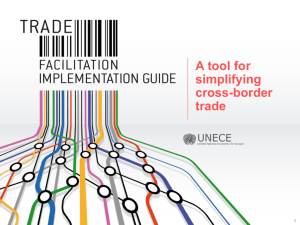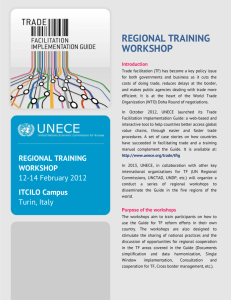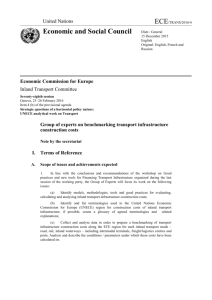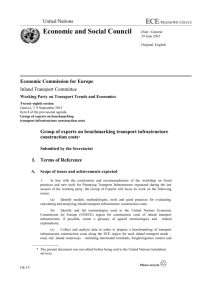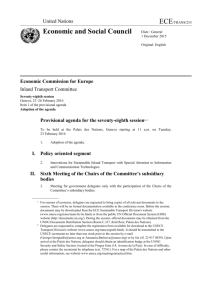UNECE – UNESCAP Transport Infrastructure Study in Balkans(TIRS)
advertisement
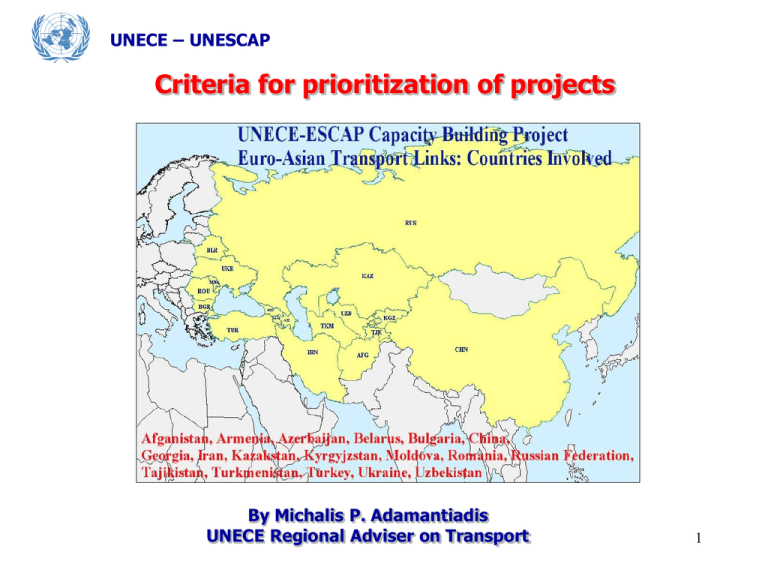
UNECE – UNESCAP Criteria for prioritization of projects By Michalis P. Adamantiadis UNECE Regional Adviser on Transport 1 UNECE – UNESCAP Background • • • • The countries have investment needs They are competing for scarce resources They provided their investment activities The 1st EGM agreed that proposed projects should be prioritized on the basis of set criteria Therefore it is necessary to set criteria 2 UNECE – UNESCAP Experience of project prioritization • • • • • The Pan-European Corridors concept Transport Infrastructure Needs Assessment (TINA) Transport Infrastructure Study in Balkans (TIRS) Regional Balkans Infrastructure Study (REBIS) Van Miert High-Level Group on Trans-European Transport Networks • UNECE TEM and TER Projects Master Plan • UNECE TEM and TER Master Plan Methodology for project prioritization • Prioritization of investments on the Asian Highway network 3 UNECE – UNESCAP The Pan-European Corridors concept • Elaborated in concrete terms at the 2nd and 3rd PET Conferences • Starting points the AGR, AGC, AGTC Layer 1: Long term perspective, as reflected in AGR, AGC, AGTC Layer 2: Medium-term corridors, for implementation up to 2010 Layer 3: Short-term priorities of Layer 2 for implementation in 5 years • The description of Layer 2 Corridors is based in part on TEM and TER networks and the following assumptions: First: Every country in CEE should be touched at least one Corridor Second: Corridors would be included if viable and be realized by 2010 Third: Corridors chosen should be consistent with network concept • Operational criteria were developed, constituting a pre-screening mechanism, based on those set by UNECE and the EC and drawing on criteria used by the international financial institutions 4 UNECE – UNESCAP Transport Infrastructure Needs Assessment (TINA) Completed in 1999 for 11 candidate countries to initiate the development of multi-modal transport networks • First stage: Concrete definition of on the network for realization by 2015, taking into account expected economic development of the countries concerned • Second stage: Identification of investment measures by which the identified network would be brought up to the desired quality level 5 UNECE – UNESCAP Transport Infrastructure Study in Balkans(TIRS) Delivered in 2002 for 7 Balkan countries to: Identify major international and regional routes Define a medium-term network Define short-term priority projects Multi-criteria analysis centered around socio-economic return of investment, functionality and coherence. Classified into 4 categories: (a) for rapid implementation (b) necessitating additional analysis most worth-wile and well defined (c) necessitating additional analysis most questionable projects (d) discarded for the moment Selection criteria were used, mostly based on TINA 6 UNECE – UNESCAP Regional Balkans Infrastructure Study (REBIS) • Delivered in 2003 for 5 countries to prepare short-term investment plans for priority projects • TIRS and TINA experiences used using a two-step procedure • First: Screening tool based on multi-criteria • Second: for selected and screened projects, pre-feasibility studies were carried out 7 UNECE – UNESCAP Van-Miert High-Level Group on TEN-T • Presented its results in 2003 • To select a restricted number of priority projects on the transport network of the expanded EU, up to 2020 • The methodology used was based in two stages: First: To ensure overall coherence of projects, maturity, and country commitment, on the basis of a number of criteria Second: Assess the contribution of the projects to 3 Community policy objectives: Added value in facilitating the mobility between Member States Contribution in territorial cohesion Contribution to the sustainable development of transport • Priority projects were divided into 3 categories: • First: Limited number of priority projects to start before 2010 • Second and third : Less matured longer-term priority projects 8 UNECE – UNESCAP UNECE TEM and TER Projects Master Plan •Started in 2003 and will be completed in November 2004, focusing 21 countries •To elaborate an investment strategy, as a complete backbone road, rail and combined transport •Built upon experiences •Based on AGR, AGC, AGTC, TEM and TER standards •For the work a prototype Methodology was used •More than 350 projects proposed by the countries were evaluated and prioritized •More information on the methodology will be presented by its author 9 UNECE – UNESCAP Proposed criteria and methodological framework Pre-selection of projects, with 3 screening levels 1.International infrastructure standards, along EATL, removing bottlenecksmissing links, facilitating landlocked -countries, within national plans 2.Project is defined, management plan exists, environmental and socioeconomic aspects considered 3.Euro-Asian dimension, no less of $ 10 million, evidence of economic viability Criteria for the selection of projects International standards, EATL added value, contribution to sustainable development Horizontal Dimension: Functionality-Coherence Vertical Dimension: Socio-economic efficiency and sustainability criteria Project Priorities: (Priority 1) Funded and implemented rapidly, up to 2010 (Priority 2) Requiring additional investigation , or implemented up to 2015 (Priority 3) Requiring further investigation, or implemented up to 2020 (Priority 4) Longer-term projects 10 UNECE – UNESCAP Thank you 11

